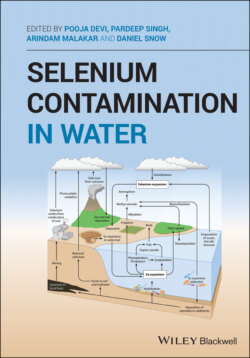Читать книгу Selenium Contamination in Water - Группа авторов - Страница 54
4.2.5 Diagnosis of Se in Soil, Forages, and in Livestock Animals
ОглавлениеSoil followed by water are the primary sources of Se for plants. The amount of Se plant uptake not only depends upon the amount of Se present in the soil but also upon the soil’s physico‐chemical properties. Na2SeO4 is the most available form of Se for plant uptake (Hawrylak‐Nowak 2013). Soil nature defines plant availability of Se. Se uptake has been found to be higher in the more heavily‐textured soils than in softer soil. The heavier‐textured soils are promoting plants to take up Se. Soil pH also has the value of plants taking up Se.
A study reported that high soil pH will increase the leaching of Se toward the sub‐soil from the top soil. Therefore, when examining Se availability in the soil, it has been well documented that soil should be tested for pH level and the soil samples should be taken at different depths according to the pH. Seleniferous soil, water, and plants respectively showed >2 ppm, >50 ppb, and >1.0 ppm. Planting should be scheduled taking into account the presence of Se in top soil or sub‐soil (Davis et al. 2000).
The overall allowable amounts for Se in human drinking water, livestock drinking water, and irrigation water are 0.01, 0.05, and 0.02 ppm, Therefore it is mandatory to diagnose the Se level in all water sources before using the water for drinking and cultivation (WHO 1987).
Plants with 5 ppm of accumulated Se caused livestock health hazards. A study reported that seleniferous plants may accumulate 15 000 ppm of Se (Rosenfeld 1964). However, seleniferous plants are not always responsible for selenosis in livestock animals. Plants grown in seleniferous soil may or may not accumulate the Se in their tissue. Plants which accumulate Se in their tissue are called obligatory seleniferous plants. Milk‐vetches, poison‐vetches and prince's plume are the some of the more common obligatory seleniferous plants (Davis et al. 2000). Livestock animals do not consume these plants because of their non‐palatability but sometimes sheep consume these plants. Other plants accumulate Se in their tissue by normal processes. These types of plant are called facultative selenium accumulators. These plants are unpalatable to the livestock animals and emit a garlic‐sulfur odor. Saltbushes, curlycup gumweed, broom snakeweed, and asters are plants in this group. If they are forage‐deprived, cattle and horses consume these plants (Davis et al. 2000). The non‐accumulator plants are also responsible for evoking selenosis in animals. Therefore, the presence of such plant species may categorize the grazing land (Davis et al. 2000).
Se is a necessary element for normal growth and fertility in livestock animals. Where there is Se deficiency or toxic Se levels, normal growth has reportedly been stunted in livestock animals, even causing death. The Se‐deficient level in grazing cattle is 0.10 ppm, and 0.03 ppm in sheep. The toxic level is 1–5 ppm in cattle, sheep, and horses. This minute gap between Se deficiency and toxicosis has to be maintained by a livestock feeding and management system. Selenosis in livestock animals produces three types of toxicosis: chronic, acute, and sub‐acute toxicity. In livestock animals there are some general diagnosed signs such as hunger and thirst, abdominal discomfort, excessive salivation, respiratory failure, dental grating, blindness, and paralysis, etc. In livestock selenosis results in hematological changes, alteration of blood biochemical parameters, reduced antioxidant enzymatic activity, etc. (Rosenfeld and Beath 1964; Davis et al. 2000).
